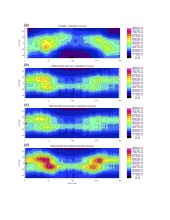COSMIC Observations and TIEGCM simulations of eddy diffusion and tidal effects on the semi-annual oscillation in the ionosphere
Qian
Wu
NCAR/HAO
Poster
It is known that the ionosphere has strong semiannual oscillation (SAO). We use the NCAR TIEGCM (Thermosphere Ionosphere Electrodynamics General Circulation Model) model to investigate the eddy diffusion and tidal effects on the ionosphere SAO. We also use the COSMIC (Constellation Observing System for Meteorology, Ionosphere, and Climate) satellite GPS radio occultation (RO) observations to valid the simulation results. The TIEGCM is driven at 97 km lower boundary by tidal and gravity wave (eddy diffusion coefficient) inputs. Adding SAO to the eddy diffusion coefficient at the TIEGCM lower boundary enhances the simulated ionosphere SAO and agrees well with the COSMIC observations. Removing the tides at the lower boundary makes the modeled ionosphere density and SAO too large compared to the COSMIC observation. The TIEGCM simulations are consistent with the diurnal signal in the ionosphere density being mostly in-situ excited and semidiurnal from lower atmosphere. Consequently, the diurnal signal is more affected by the eddy diffusion related electron density SAO than the semidiurnal variation.

Poster PDF
Abstract file